
The Battle Of Milne Bay – Then and 75 Years On
“Here we were, anti-aircraft gunners with batmen, cooks drivers and others with a rifle each (we hoped), rain pouring down, nothing between us and the beach where the Japs were possibly going to land. The regular infantry was behind us.” (CJE Rae)
Cecil Rae (VX 48132), was a chronicler and story teller. He kept a diary as a young man so when he departed Australia with the Regiment in December 1940, he took a small diary with him and also his camera. In his later years he condensed his diary entries and added his photos as well as maps and descriptions so that we, his children, have a record of his war time experiences. He also used this material to contribute to the writing of On Target The story of 2/3rd Australian Light Anti-Aircraft Regiment in conjunction with Les Harris (VX 27594) and Ron Bryant (VX 32563).
In August 2017 we were very fortunate to participate in a trip to Papua New Guinea to commemorate the 75th anniversary of the Battle of Milne Bay. 9th Battery (‘A’ and ‘C‘ Troops) participated in the battle. So armed with Dad’s diaries and photos we arrived in Port Moresby with 10 other descendants of infantry, artillery and airmen who had also participated in the battle.

Cec Rae At Mine Bay 1942
Bay 1942
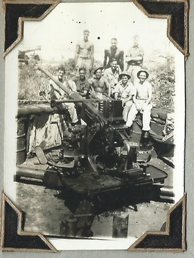
Cec’s Bofors and Crew At Milne
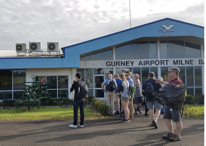
August 2017 Commemorative tour to Milne Bay Gurney Airport Milne

Our tour group inspects the Bofors gun at 40mm Bofors anti-aircraft gun similar to the guns used by the 2/3 Australian Light Anti-Aircraft Regt and in particular by 9th Battery in Papua New Guinea.
Bay in 2017.
Our trip was made possible entirely by Thales Australia which is an international electronics , manufacturing and systems company supplying the defence, aerospace, security and transport markets. Accompanying us was a senior historian from the Australian War Memorial, one serving and one retired officer from the army, Thales organisers and young ambassadors, and personnel from No Roads Expeditions. A Melbourne tourism company, No Roads organises trekking, re-enactment and commemorative trips to areas such as Kokoda, Milne Bay etc. They provided on-the-ground expertise and security as well as additional historical advice.
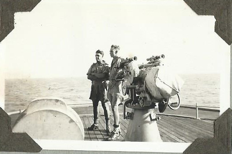
On Friday 12 June 1942 we embarked on MV Macdhui (our bombing of the equipment went per SS Karsik). We passed the entrance to Morseby at 5pm on 15th June”
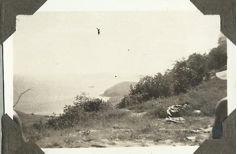
“In the distance is the entrance to Moresby. The Macdhui was viewed from this hill on the 18 June”
Our commemorative group arrived at Moresby on 22 August 2017. We visited the Port Moresby WW1 War Memorial and then to the wreck of the Macdhui.

Arriving at Port Moresby in 2017.

The wreck of the MV Macdhui in 2017.

Ian and Anne Rae at the Bomana War Moresby

Bomana War Cemetery with our group Cemetery near Port
The following day our group held a very moving commemorative service at the Bomana War Cemetery and laid a wreath in memory of the men and women who paid the ultimate sacrifice in New Guinea.
David Horner in The Gunners, A History of Australian Artillery Allen & Unwin, 1995 , explained why 9th Battery had been moved to Port Moresby from Townsville:
“Earlier in the year [1942] Japanese elements had seized Lae and Salamaua, on the north coast of New Guinea, and later they occupied other centres such as Wewak and Madang. It took some time before Rowell [Commander New Guinea Force] and his staff in Port Moresby could fully grasp the danger posed by the Japanese thrust towards Kokoda, across the forbidding Owen Stanley Ranges. In the meantime, attention was focused on a second Japanese thrust, towards Milne Bay at the south-eastern tip of New Guinea.
As early as May MacArthur had decided to build several airstrips at Milne Bay from which planes could attack Rabual. A small garrison began to assemble, and by July it included the militia 7th Infantry Brigade with three battalions and the 4th Battery, 101st Anti-Tank Regiment, from Townsville, two 3.7-inch guns of the 23rd HAA Battery from Port Moresby, the 2/6th HAA Battery and the 2/9th LAA Battery (less one Troop), both recently back from the Middle East, and a US anti-aircraft battery. A month later further reinforcements arrived in the form of the AIF 18th Brigade with three battalions and the 9th Battery, 2/9th Battery, 2/5th Field Regiment. In addition, two RAAF Kittyhawk fighter squadrons were based at Milne Bay. ….
Milne Force faced immense difficulties. The area was drenched with almost continual rain, the few tracks in the area were usually impassable to vehicles, the maps were rudimentary, communications were poor, and the force had been hastily assembled. There was no clear artillery command structure and the officer commanding the 2/9th LAA Battery, Major Garfield Margetts, apparently acted as Anti-Aircraft Defence Commander.”
So 9th Battery departed from Townsville and arrived in Port Moresby three days later. Several days after disembarking, the ship on which they had travelled, the MV Macdhui, was bombed by the Japanese and sunk in Port Moresby harbour. A and C Troops of 9th Battery were then transported to Milne Bay by sea while ‘B’ Troop remained behind to defend Port Moresby.

The Battle of Milne Bay was the first time that the Japanese were forces moving towards Australia.
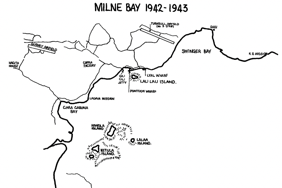
Milne Bay
Map of Milne Bay area taken from “On Target
Arriving in Milne Bay on 25th June, Cec wrote “There was a small flat coastal area beyond which jungle covered mountains reached to the grey skies. The Bay narrowed towards its inland reach and had small islands dotted about it.”
Arriving in Milne Bay on 25th June, Cec wrote “There was a small flat coastal area beyond which jungle covered mountains reached to the grey skies. The Bay narrowed towards its inland reach and had small islands dotted about it.”
“Also in the early stages, besides being on duty on the gun we were employed as road makers and the unloaders of ships. The latter tasks had its advantages as we were able to divert some of the supplies our way which improved our standard of living. Also at this time our Battery trucks were the only ones available in Milne Bay and were used for a great assortment of duties. In particular was the conveyance of cases of beer which apparently fell off the back of the trucks at frequent intervals much to the joy of the members of 9th Battery. Also transported were perforated metal sheets for laying on the airstrips. (Marston mats) These sheets were taken to their destination, a rope tied to them and to a coconut tree, then the truck moved forward so unloading the truck.”
“On July 7th we were told that in the event of a Japanese landing we would be organised as infantry – not a good thought.

Our group at the start of the

Kokoda Trail in 2017


Marston matting as used on Milne Bay air strips to assist planes
to land on the mud. This photo is taken on the way to the start
of the Kokoda Track.

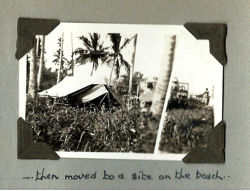
“On Target” states “The War Diary of 9th Battery on 11th August 1942 records that there were 4 guns of A Troop 2/9th Australian Light Anti-Aircraft Battery defending Guerneyfield (No.1) air strip along with additional anti-aircraft defences from 23rd Australian Heavy Anti-Aircraft Battery, 2/6th AHAA Battery and 101 and 104 Batteries, U.S. Army. Defending the Pontoon Wharf at Gili Gili were the four guns of C Troop 2/9th ALAA Battery”
Cec’s gun was situated on Lau Lau, a small island off the Gili Gili wharf.
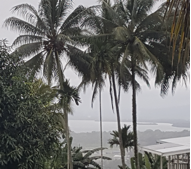

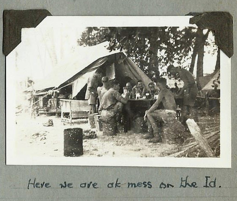
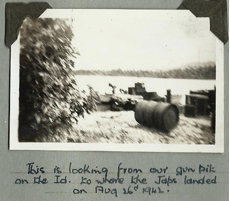
Sketch of Lau Lau Island made by Cec..
Looking towards Lau Lau Island and Gili Gili in 2017
“The gun was positioned at Pyming Point on the north west corner of the island, the machine gun was situated on the east side of the island. The island was about 1½ acres in extent and was about half a kilometre off the shore to the north where the first (Pontoon) wharf was situated. This is where the Anshun was shelled and sunk. Fortunately we had been taken off the island and repositioned at Ladava Mission.
I almost forgot the latrine which was situated at the end of a small jetty we had built. On the south side of the island. While sitting one could be amused by watching the coloured fish below.”
On 21st and 22nd July, there were large concentrations of Japanese warships at Gona and Buna, where landings were made on 22nd July. From the 4th August on air raids and strafing by the Japanese on Milne Bay became regular. The Japanese were engaged by the anti-aircraft defences and then 75 and 76 Squadron RAAF fighters. It was not until 28th August that the full complement of ground forces arrived numbering 8,824 (Australian Army 7,459; United States Army 1,365); the infantry, however, numbered only about 4,500.
On Target reports from the 11th August Communique S.E. New Guinea “7 Zeros north of Samarai (island in Milne Bay). In an engagement 2 Zeros were destroyed and 3 damaged or hit Our losses 1 destroyed 1 damaged.” (A member of Battery H.Q. recorded the losses as 3 Zeros and 3 Kittyhawks.”
Red warnings were received on 15th, 17th and 20th August, but no aircraft were sighted. Also during this period, heavy rains and high tides were experienced, making conditions very unpleasant.
The War Diary of 9th Battery on records: “Command Milne Force passed to Major General Clowes”. “24th August Showery. Cleaning ammunition but interrupted by a red warning — all clear soon after. 1455 Another red warning, about 10 Zeros flew in attempting to strafe the ‘drome. Engaged by Bofors and Heavy A.A. then by Kittyhawks. Two Zeros brought down.
On the night of 25 August 1942, 2,000 Japanese marines were landed to capture the three air strips and facilities at Milne Bay. The marines landed 11 kilometres east of their intended landing area, and their intelligence underestimated the Allied numbers, believing that there no more than a few hundred troops defending the airstrip. There were actually almost 9,000 Allied troops including the air support from 75 and 76 Squadrons. Initially, the Japanese met with success. Supported by two light tanks, they advanced westward. The 61st Battalion was first into action and slowed the Japanese, although unable to hold them back. The 2/10th Battalion was moved up on the night of 27 August, but were repulsed and had to withdraw. Reaching the edge of the eastern most (No.3) airstrip on 28 August the Japanese operations fell away as they made preparations for their attack, which included landing 800 reinforcements. In the early hours of 31 August they charged the defences of the air field. The Japanese suffered heavy losses, largely due to machine gun and artillery fire, and withdrew by dawn. Throughout their operations the Japanese were constantly harassed during daylight hours by the P-40s.
At daylight on 31 August, the commander of Milne Force, ordered a counterattack and pursued the retreating Japanese. Despite fierce fighting the Australian infantry steadily advanced along the north shore of Milne Bay.
Between 4 and 7 September the Japanese were evacuated at night from around their original landing areas. Of the 2,800 Japanese landed, only 1,318 re-embarked. It was estimated that up to 750 lay dead around Milne Bay and the majority of the remainder were killed trying to escape overland to the Japanese base at Buna. Allied deaths included 167 Australians and 14 Americans. https://www.awm.gov.au/collection/E84334
In the official records that we have read there is little emphasis placed on the impact of the Japanese naval shelling of the allied shipping (for example the sinking of the Australian vessels the Anshun, the Elavala and the Bronzewing) and the associated loss of life, and on the coastline and the wharf area which 9th Battery were defending. 9th Battery were often subject to enemy naval shelling. For example Cec’s memoirs report in part that on the 26th August:
“18.50. Red Warning.
19.48. All Clear. Went to bed around gun-pit.
21.30. Awakened by shelling. Some shells landed very close to C.4. [Jim Paton] & some very close to us – very unpleasant.[My memory was that search lights were focussed on the Island and a shell or two landed fairly close. Ian Evans & I were crossing a causeway on our way to the men on the other side of the Island when a searchlight picked us up & we froze. Nothing happened]
21.50. Shelling stopped.
[Note: We later learned that a shell had landed at the base of the outside of a gun pit near the wharf.
One more meter and the crew would have been lost.]”
“29th August After tea our crew went to other side of island & were just sitting down when received word to evacuate. The fourteen of us got into the rowing boat & left.
Note: This was after removing the breech block from the gun to make it unusable.
Took up infantry positions as beach defence.(See initial quote) One cruiser & 8 destroyers are headed this way. Raining.
11.50 Large flashes on horizon we expected shells to land – heard nothing.
Mick, Hass & I are together – working as spotter between us. Sleeping in nearby tent when we can.”
The following extracts from Milne Force Anti-Aircraft Weekly Intelligence Summary No.4 describe the anti-aircraft including 9th Battery’s contribution to the Battle:
“1. Forces at our disposal Land Defence: For the night of 28th/29thAug. One 40mm gun C.2 was moved from site on waterfront to a position near the junction of Routes 1 and 2 to act in an anti-tank role covering the breakthrough of any tanks from direction of No.3 Strip. This gun was moved back at dawn “4. Action 24th Aug. Raid No.3 At 1446 Porlock Harbor reported a large number of aircraft flying N.E. to S.W All available P.40s were sent up and gun sites “Stood To” at 1500 hours. At 1523, 8 enemy fighters approached Strip No 1 apparently with the intention of a strafing attack. All gun sites heavy and light engaged the aircraft until our P.40s intercepted. Several hits were registered and 3 aircraft were probably brought down by L.A.A .fire. “All our P.40s returned safely after the action. There was no damage caused. A.A. fire effectively prevented the enemy from attacking any ground targets.
“27th Aug. Raid No.4 Gun sites were “Stood To” at 0744 hours. At 0813 8 bombers escorted by 12 fighters (approaching). A.A. sites engaged at 0814 and effectively broke up the formation. The fighters came in towards the Strip, but were turned away by A.A. fire. The bombers continued up the Bay in the direction of the Mission (KB) where the fighting is going on.
Fighters and bombers were engaged all over the sky by A.A. fire, which had an open go as the 6 P.40s were absent on patrol. The first serious attempt to strafe the Strip was made at 0830 by 5 fighters, and during this attack one B24 on the ground was set on fire. In this and subsequent strafing attacks on the Strip L.A.A. fire claimed many hits, with almost certain destruction of 6 enemy aircraft including one bomber. Bombs were dropped near the Strip (4), the A.A. site M.3 (2) and the area where 61 and 9 Inf. Bn are engaging enemy land forces.
M.3 shot down one bomber over the sea. At 0845, 6 B26 Allied bombers flew in from the East and in an engagement with enemy fighters, one type “0” fighter (Japanese) was shot down over the sea. Later reports from the R.A.A.F. state that P.40s shot down 2 fighters, 1 dive bomber, and 1 dive bomber probable. The A.A. fire was sustained and accurate and in addition to shooting down planes, had the effect of preventing the enemy air craft from carrying out any effective bombing.
“31st Aug. Raid No.5 …. and at 1141 hours gun sites identified the aircraft as type “0” Mitsubishi seven in number.
At 1145 M.3 engaged at a height of 15,000 feet followed by M.2 — no hits were observed…
7. General. As well as the air raids during the period A.A. sites have been very interested in the operations by land and by sea Naval shells have burst and landed very close to M.3 and M.32, and all sites have maintained patrols and “Stood To” when attack has appeared imminent All sites particularly M.3 and M.32 on the coast have been passing valuable information re lights, flares, shipping and operations. M.3 was used in a coastal defence role. Morale of A.A. personnel has been very high throughout the one complaint being ‘that Tojo is using too much naval and not enough air support for his ground forces.’ “ (Note: M.2, M.3 etc refer to geographical positions at Milne Bay.)
The War Diary of 9th Battery records: “6th September. “Anshun” sank. “C” Troop H.Q. hut and C.2 Det gun-pit received direct hits with 4″ to 6″ shells. 2 “C” Troop personnel slightly wounded” .
On 13th September a census of the health of the men of “C” Troop was taken. The healthiest gun detachment had five men who had not contracted malaria. There were at that time 17 members of the Troop in hospital. “A” Troop’s health at that time was worse than “C” Troop. (On target)
Whilst the Battle of Milne Bay was over on early September, Cec’s diary records that there were Japanese air raids daily through to January 1943 and continued less regularly through to April 1943 during which the men stood to the guns and fired when necessary. He recorded on 17th January, then situated at No 3 strip, after a bombing raid “When we looked around there were fires everywhere. A few of our bombs exploded & some petrol dumps & planes went up. An anti-personnel bomb landed about 75 yards away – a piece of the bomb took a slice out of the vertical sight & made a gash in the breech casing. Several pieces of metal landed in the pit [where (we) were sheltering]”.
“B” Troop joined “A” and “C” Troops in Milne Bay on 21st October 1942 and in the following year – on 4th October 1943, 9th Battery moved to Lae as part of the new 2/3rd Australian Composite Anti-Aircraft Regiment.
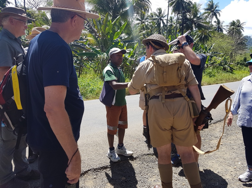
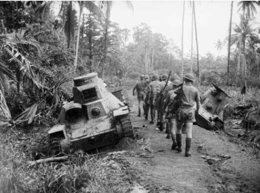
Captured Japanese tanks and Allied infantry 1942.
Tour group visits site of the capture of Japanese tanks.
(AWM Photo) Our Thales leader and our historian/re-enactment specialist from No Roads Expeditions speaks with the son of a New Guinean who participated in the battle of Milne Bay.
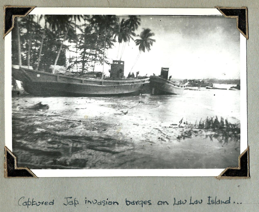
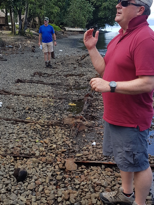
Our tour group visits the remnants of the
Japanese landing barges.

The site of No. 3 Strip Turnbull airfield and monuments including
captured Japanese artillery on the left.
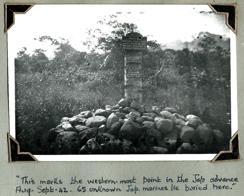
Taken by Cec in 1943 while the Battery was still at Milne Bay.
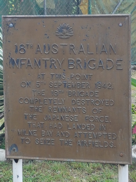
“18th Australian Infantry Brigade. At this point on 5th September 1942 the 18th Brigade completely destroyed the remnants of the Japanese force that landed in Milne Bay and attempted to seize the airfields.”

Descendants and the Hon Richard Marles laid Bay. School children sand the PNG national anthem from No Roads Expeditions after the commemorative service at the Milne Bay

Descendants , The Hon. Richard Marles and historian and re-enactment specialist and local people attended. war memorial.
Our sincere thanks go to Thales and the organisers and for 2/3 ALAAR Association Committee for making this very fascinating and memorable trip possible.
Anne and Ian Rae
References:
On Target 1987 Rae CJE, Harris AL, Bryant RK
Australian War Memorial Battle of Milne Bay website
2017 photos by Anne Rae
Old photos from Cecil Rae’s photo album except for “Captured Japanese tanks” which is copied from the Australian War Memorial website.
Cecil Rae’s diaries
Cecil Rae’s unpublished memoirs Me Me Me.
